LESSON 22: The Homing Coins
Three Coin Classics are taught you in this lesson:
1 -- Fifteen coins are counted into a hat by a spectator. He removes two, and suddenly they disappear from his hand. He counts the coins in the hat again and finds that the two have mysteriously returned.
2 -- Fifteen coins are held tightly in a spectator's closed hand. Two are removed and placed in his other hand, yet they wander back.
3 -- A great trick -- amazing in its effect. A marked coin is wrapped in a piece of newspaper and given to a spectator to hold. Upon unwrapping the paper, it is discovered that newspaper has been transformed into a nest of three envelopes, the innermost containing the marked coin. Then the envelopes are changed back again to the original sheet of paper in spectator's hands.
LESSON 22
Coin work permits of some wonderful effects. Here you learn three coin classics.
The first and second are based on a popular magical experiment called "Multiplication of Money". David Devant, noted English conjurer, calls it "Magical Addition", for in no part of the experiment does the money multiply. The third is also a version of an experiment popular among the older magicians, but seldom seen today. In Devant's hands, this effect was a thing of beauty. I have thoroughly analyzed the effect until I arrived at a simplified, modernized method for working it.
1. THE HOMING COINS
EFFECT:
Performer shows a plate of coins, then pours them into a borrowed hat which a boy is holding. He says that he placed fifteen coins in the hat, but the audience is a bit skeptical as the coins were not counted. Boy counts the coins and finds that there are actually fifteen. Coins are poured back into the hat again. Boy then gives performer two of the coins, which leaves thirteen in the hat. The two are wrapped in a handkerchief and given to the boy to hold. Mysteriously the coins wander back into the hat from the handkerchief. Boy counts the coins from the hat onto the plate and finds that there are fifteen as at first. Magician repeats the experiment, leaving the audience as thoroughly puzzled as ever.
PARAPHERNALIA:
1 -- Seventeen coins, all alike. Half dollars or palming coins are best.
2 -- A small china plate.
3 -- A small piece of magician's wax.
4 -- A prepared handkerchief -- with two coins, the same as those used in the experiment, sewed into the corner.
Sew square of white cloth large enough to cover coins over one corner of the handkerchief, making a pocket. Put another piece of cloth between the two coins to keep them from clinking when handkerchief is handled carelessly. Now insert coins in pocket of handkerchief and sew them in. Figure 1.
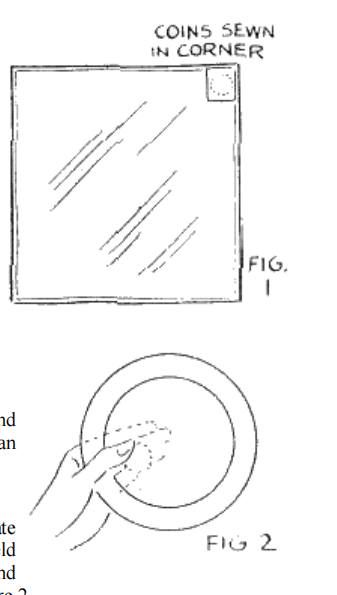
This pocket is made the same way as the one in Figure 11, Lesson 14, in which you sewed in pieces of a card.
SECRET AND PATTER:
To Prepare:
The prepared handkerchief should be in one of your right pockets.
Rub the small piece of wax well between the fingers to make it soft and stick it on your lower vest button. The piece of wax need be only about an eighth of an inch in diameter, or less.
Have fifteen palming coins on the plate.
Place two coins in left hand in position for Finger Palming. Take plate with coins in left hand, fingers under it and thumb on top. Coins can be held between fingers and plate easily, and because of natural position of hand holding plate, audience will not suspect that you have coins concealed. Figure 2.
To Perform:
Come forward with plate of coins in left hand and two coins concealed underneath.
"To begin with, I want to borrow a boy -- a boy that would be interested in money. Ah, there is a boy who looks like a good financier. I know that you will be glad to help me to mystify this audience financially. (Get boy to start forward.) By the way, we must also have a hat. Will some gentleman please give my friend his hat for a little while? There is one. Just bring it along with you."
To make it easier to get the boy to come up, you should come closer to audience. Pick out a boy and beckon to him and help to get him to the platform. As he comes forward, take his arm and lead him up to the center of the stage. Have boy stand at your left.
"Before we start with financial affairs, it might be well for us to get acquainted and exchange references.
What is your name?"
Boy tells his name. We shall assume that it is John.
"John. That's a good name. My great-great grandfather's name was John. They named Johnny-Cake after him. Well, I'm glad to meet you. I have a lot of confidence in you and I suppose you have a lot of confidence in me. Of course, the audience has confidence in us for we wouldn't fool them for the world, would we, John? You see you can trust John implicitly."
To gentleman who loaned his hat:
"You do not mind if John uses your hat for a bank?" (To John) "See whether there is anything in the bank.
Examine the hat carefully."
Boy examines the hat and finds it empty.
"What's the matter? Is the bank empty? Sort of short of funds, eh? John, if you will hold the hat over here for a moment I shall put some money in the bank, and we'll start a banking proposition."
Boy brings hat close to you. Turn plate so that coins fall into hat. Hold plate tilted a little above the hat so that audience can easily see the coins falling into the hat.
"Those were thirty-dollar gold pieces that I put into the hat -- thirty-dollar gold pieces made of platinum. FIFTEEN of them. Hold the hat tight, John, so that the fifteen coins will be safe."
Look at audience, then look at John, then back to audience again, and then at John again.
"John, I hesitate to say it, but there are a few people in the audience -- I shall not mention any names, of course -- who have a sneaking suspicion about the number of coins which I put into the hat. Just think of that! I put fifteen thirty-dollar gold pieces made of platinum in the hat, and they doubt my word. Of course, John knows that there are FIFTEEN coins in the hat, don't you, John? (Whisper to John to say, "No".) No? I doubt very much whether you are acquainted with thirty-dollar gold pieces made of platinum. To convince everyone that a magician tells the truth, I shall ask John to count the coins onto the plate one at a time. Count them out loud."
One by one, John counts coins out onto plate. If he does not speak distinctly, count with him so that audience can have no doubt as to the number of coins.
"FIFTEEN — no more, no less. All right, we'll place them back in the bank."
Pour coins back into hat again. Be sure to hold plate so that audience can see coins dropping into hat. As coins slide down, release the two concealed in your fingers and let them slide down with the rest into the hat. To do this bring edge of plate near top of hat. Figure 3.
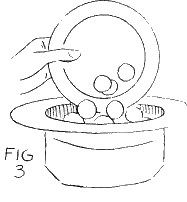
There are now SEVENTEEN coins in the hat instead of fifteen. Audience, of course, thinks there are fifteen.
Place plate on table.
"John, take TWO coins out of the hat and give them to me."
Take the two coins which John gives you and show them to audience to convince them that there are two coins.
"One -- two."
Whisper to John to turn hat around in a circle.
"What's this? Passing the hat around? You must be a deacon. Hold the hat up high -- as high as you can reach comfortably."
When the hat is held high, John is prevented from looking inside and counting the coins.
Show the two coins you have, one in each hand, flat sides of coins to audience.
To John: "Two from FIFTEEN is thirteen, isn't it? You aren't superstitious about holding THIRTEEN coins, are you?" (To audience) "John says that thirteen are better than ten. He has an eye for business."
Place both coins in left hand. Reach into pocket and bring out the prepared handkerchief. Place it over your left arm, then take coins with right hand. Place handkerchief over left hand with the ends falling down. Have faked end near you and away from audience.
Show both coins slightly apart and place them in center of handkerchief in left hand. Grasp coins through the handkerchief with tips of fingers and thumb of left hand. Figure 4.

Now as you bring right hand up towards coins, catch the faked corner of handkerchief between third and fourth fingers. Grasp coins between first and second finger tips of right hand. Figure 5.
With left hand throw handkerchief over coins and your right hand and pretend to pick up coins in left hand through the handkerchief. In reality you grasp the coins in the faked corner and FINGER PALM the free coins in the right hand. Draw right hand downward and away as left hand lifts handkerchief up.
"I shall wrap the two coins in this handkerchief and ask you. John, to hold them securely. Hold the hat in your right hand and the handkerchief and coins in your left."
Give handkerchief to John so that he grasps the coins. He feels them and believes he is holding the two coins you just put under it. The ends of the handkerchief hang down.
Be careful of your ANGLE OF VISIBILITY with the coins Finger Palmed in your right hand. Neither John nor the audience must see them.
"You feel the two coins all right through the silk of the handkerchief, do you? Good! Hold them tight. Imagine you are Scotch. The money which I took from the bank reminds me of homing pigeons -- take them away but they fly back again. John, what would you say if the two coins you are holding should fly out of your hand into the hat? Say, 'Go.'"
As John says, "Go", take hold of a corner of handkerchief with left hand. Whisk it from his hands suddenly, and to all appearances the coins have mysteriously vanished.
"I guess they went."
Take handkerchief in right hand, and as you pick up plate from table with left hand, place handkerchief in right pocket. Now transfer plate to right hand, thumb on top and fingers concealing two coins under it.
You now have the same arrangement that you had in your left hand when you began this experiment.
"Count the coins! in the hat, John, to see whether the two coins flew back to the bank again. If so, there should be FIFTEEN again, instead of THIRTEEN. Count them one at a time out loud".
John counts coins onto plate.
"Fifteen. They did come back. By the way, John, would you like to have me teach you this trick so that you can do it? You would. Then you shall have a lesson. The most important part is to be able to get as many as FIFTEEN coins together all at once. Place them on a plate, or platter, if you like. Get someone's hat and pour them into it, all FIFTEEN. Sometimes the audience doubts you, that is why I had you count them one at a time out loud."
As you say, "Pour them into it", pour the coins back into the hat as you did before and let the two coins in your right hand slide into the hat with the others.
"Usually someone holds the hat but as no one is handy, we'll just set it down over here on the table. But before we do that, take out TWO coins." John takes out two coins. "Place the hat on the table." Boy places hat on table.
"And give me the two coins."
Take coins in left hand and as you do so, pick ball of wax from lowest vest button with tips of first finger and thumb of right hand. Bring coins over to right hand and press the wax on center of coin towards you. Press it out flat with right thumb to spread it on coin. You can do this easily without being detected.
"Of course, that leaves THIRTEEN in the hat. Now watch what I do with the coins."
Have waxed side of coin toward you. Have second coin in front of first, toward audience, but keep them a little apart. Hold coins in left hand.
Show both coins plainly so that all can see the two of them. Move waxed coin away a few inches with right hand and replace again on other side of second coin so that wax is between the two.
"Are you watching both coins, John?"
Turn left hand to audience as in Figure 6A. Screen coins with right hand, apparently taking coin from behind, but in reality push two coins together and press tightly with fingers and thumb of left hand. Figure 6B.

Remove right hand fingers as though taking the coin. Open them slowly and show that coin has vanished.
"There is one gone."
Throw double coin over to right hand and then back to left. The coins will hold together as one, and no one will notice the extra thickness. When holding coin up to audience, flat side should be exposed.
Hold double coin in Finger Tip Clip position (Lesson 21, Figure 16). Pretend to throw it into left hand, which closes as though holding coin. During throwing motion, Front Thumb Palm double coin in right hand. Point index finger toward closed left hand and make motion toward it. While doing this, raise hand to upper left coat pocket and let coin drop into it. (See Lesson 21.) Open left hand and show that coin has vanished. Now show both hands, fingers spread wide apart.
"And the second one has likewise melted away. But, as you know, John, they really flew back into the hat -- that is, if you have done the trick properly. Pick up the hat and count the coins one at a time again onto the plate."
Boy picks up hat and you pick up plate. He counts the coins aloud.
"FIFTEEN. There, John, you have performed the trick well, and if anyone wants to hire you to bring their money back again, I'll give you a good recommendation."
Dismiss boy and return hat, or you may retain him or the hat for another experiment.
2. INVISIBLE MONEY TRANSIT
Another version of the "Multiplication of Money" experiment.
EFFECT:
Performer brings forward small plate on which are fifteen coins. These he pours into a spectator's hand, who counts them one at a time onto the plate to prove that there are fifteen coins. Performer is given two of the coins, and then the rest are again returned to spectator's hand. Thus thirteen are left in the hand. Magician wraps the two coins in a handkerchief and gives them to spectator to hold also in other hand. Upon command the two coins disappear from the handkerchief and appear mysteriously with the thirteen coins. Spectator counts coins one at a time and finds that he holds fifteen in his hand.
PARAPHERNALIA:
1 -- Seventeen coins, preferably palming coins or half dollars.
2 -- A small plate or saucer.
3 -- Special handkerchief with two coins sewed into corner, as described in preceding experiment.
4 -- Small piece of wax, as in above effect.
SECRET AND PATTER:
To Prepare:
Place small piece of wax, less than an eighth of an inch in diameter, on bottom button of vest. Put special handkerchief in a handy pocket.
Have fifteen coins on plate and two under it, held in hand, as in preceding experiment.
To Perform:
Come forward with plate and coins arranged as described, holding them in left hand.
Have spectator come up from audience and stand at your left.
"I have had people say that they liked the experiment I am about to perform because there is money in it. I suppose, sir, that you too are interested in money. Now, I have a whole plate of it. These are thirty-dollar gold pieces -- I do not know what they are made of, perhaps white gold or tin." Pick up one coin and show it to audience. Replace it on plate.
"There are fifteen of these coins."
Pour coins from plate into your right hand, keeping coins under plate in position. "I will ask you to take them."
Give coins to spectator helping you.
"And count them one at a time out loud cm this plate as I hear a peculiar vibration passing through some of the members before us signifying their doubt as to whether there are fifteen coins." Spectator counts coins one at a time aloud and places them on plate. If he does not count loud enough, count with him. Be sure that everyone is satisfied that there are fifteen coins.
"Fifteen. You are to be congratulated on your counting."
Grasp plate with right hand and pour coins into left hand. Hold back of plate toward audience in this case. Pour the fifteen coins into the left hand with the two coins already there. Figure 7.
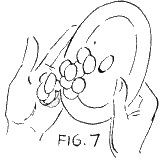
Now give coins to assistant.
NOTE: If you desire, you may pour the coins from the plate into your right hand, also releasing the two coins from under the plate and allowing them to drop with the rest. Or if you prefer, coins may be poured directly into assistant's hand, holding plate in left hand.
"Please hold the FIFTEEN coins again -- in your left hand."
When spectator has coins in hand, say,
"Close your hand tightly so that none of the money will evaporate. They say that money is hard to hold onto. That's why I want you to hold the coins tight."
The real reason is that you do not want him to see the coins and count them.
"By the way, before we go any further, I want to borrow TWO of the coins. Will you give me just two of them?"
Take the two coins from spectator.
"Now close your hand tight again. Pretend you are a Scotchman whose wife has asked him to buy her a new hat."
Take small piece of wax from vest button with right hand and press it onto the center of one of the coins. Keep waxed side toward you and away from audience.
Hold coins in full view in left hand. Slip front coin back of the other so that wax comes between them. Do not press together as yet.
Reach into pocket and remove special handkerchief with right hand. Throw it over left arm. Transfer two coins to right hand, then cover left hand with handkerchief and place coins at left finger tips. Grasp them thorough the handkerchief. Be sure to have faked corner of handkerchief away from audience.
Wrap up the two coins as you did in preceding effect, raising the faked corner to center and wrapping coins therein. Grasp fake corner through the handkerchief in left hand and with right press the two free coins together.
FRONT THUMB PALM the double coin in right hand and remove from under handkerchief.
"Will you please grasp the two coins with your thumb and finger tips of your right hand? Now keep your hands apart."
Give handkerchief to spectator so that he grasps the faked corner in the center of it. He holds this in right hand and the rest of the coins, supposedly 13, in his left hand. Fig. 8 shows position of assistant.
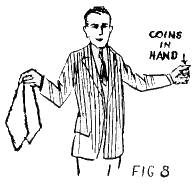
Now raise your right hand to upper left coat pocket and drop double coin in it. It will not click if pocket is empty for wax holds the two coins tight together. It is well, as suggested before, to have a little stiffening in upper part of pocket to keep it open. Sometimes a fountain pen in one corner of the pocket answers the purpose.
"Do you feel them? Just hold these two coins in Scotchman fashion. Imagine you are a banker and someone wants to borrow some money. It takes a magician to get money from some people nowadays. Anyway what I intend to do is to cause the two coins over here to jump back with the other coins over there. You would, no doubt, be surprised to see them jump. Of course, they may jump without your seeing them. They say it is hard to see money sometimes, especially when it is scarce. There is a lot turned out of the mint that you and I never see."
Take hold of one corner of the handkerchief.
"Are you ready to see the money go? Money goes fast -- usually faster than it comes, so watch closely. You still feel the coins, sir? All ready — Go!"
Whisk handkerchief suddenly out of spectator's hands. The coins in it have apparently vanished.
"They've gone."
Place handkerchief in pocket or on table as you pick up saucer.
"No doubt, you feel the weight in your left hand heavier by two coins. Please count the coins out on the plate again, and you will find that instead of thirteen coins you have FIFTEEN for the two coins have passed over into your left hand."
Assistant counts coins one at a time aloud until the fifteen have been counted. "FIFTEEN."
NOTE: In case you are performing and have no wax handy, vanish one of the coins in your upper left coat pocket, then drop the other coin in another pocket when convenient.
Or you may use this ruse for vanishing both coins. Take out your watch for the purpose of taking the assistant's pulse. As you do so, drop both coins into your pocket.
Hold assistant's wrist for a few seconds, then say, "Yes, your heart is all right." Replace watch in pocket and proceed with experiment. Sometimes I allow two coins to remain Finger Palmed until I jerk handkerchief from spectator's hand. Then I place coins and handkerchief in pocket.
3. THE COIN IN THE MAGICAL ENVELOPES
This experiment is really a Coin Classic. When skillfully done, its effect is wonderful.
EFFECT:
Performer requests that a spectator mark a half dollar and loan it to him. He wraps this coin in a piece of newspaper and gives it to spectator who is assisting him to hold. He then waves a piece of sealing wax over the parcel. Spectator opens newspaper and finds that it has been converted into a large newspaper envelope sealed with wax. Upon opening the envelope, he finds that another sealed envelope is enclosed in the first. The second envelope is opened and it contains a third sealed envelope. The third is opened and is found to contain the half dollar.
Magician then offers to show assistant how to do the trick. He repeats it and this time the envelopes are opened and the loaner of the coin finds his marked coin in the third envelope.
Performer then suggests that assistant might like to keep the six envelopes as a souvenir. He gives the assistant the envelope crushed into a ball. A mishap occurs however. Magician accidentally touches the assistant's hand with the sealing wax and this causes the envelopes to change back again into the two pieces of newspaper which they were originally.
PARAPHERNALIA:
1 -- Three copies of the same newspaper.
Select a sheet and remove it from each of the three newspapers. Use single sheets (double sheets cut in half).
2 -- Two half dollars with the same date. Put small cross marks exactly alike on each.
3 -- A borrowed half dollar. Borrow one which matches the others as nearly as possible.
4 -- Stick of sealing wax.
SECRET AND PATTER:
To Prepare:
Take one of the three selected sheets of newspaper and out it in two, from top to bottom and not across. Figure 9.
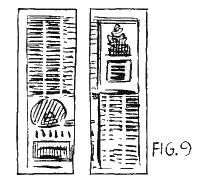
Take one of these half sheets. Cut from it three squares of paper in
the following sizes:
1 -- 8 1/2 x 8 1/2 inches
2 -- 7 1/2 x 7 1/2 inches
3 -- 5 1/2 x 5 1/2 inches
From each of these squares you are to make an envelope.
Take the largest square. Fold over one corner about three inches. Figure 10.
Now fold over the corner on the right side. Figure 11. And finally fold the corner on left side. Paste these corners down to make an envelope. The open corner forms the flap. Figure 12.

Make envelopes of the other two squares also.
Fold down the flaps. Through the crease in the top of each cut a slit about an inch and three-quarters long with a sharp knife.
Take one of the half dollars and insert it halfway into the smallest envelope through the slit. Fold down the flap and seal it with some sealing wax. Figure 13.
Place this envelope in the next largest one with the coin protruding from the slit. Fold over flap and seal with wax. Then insert these two sealed envelopes in the largest one with the coin protruding from the slit. Seal down the flap with sealing wax. You now have a package of three envelopes with a half dollar sticking out halfway through the slits. Figure 14.
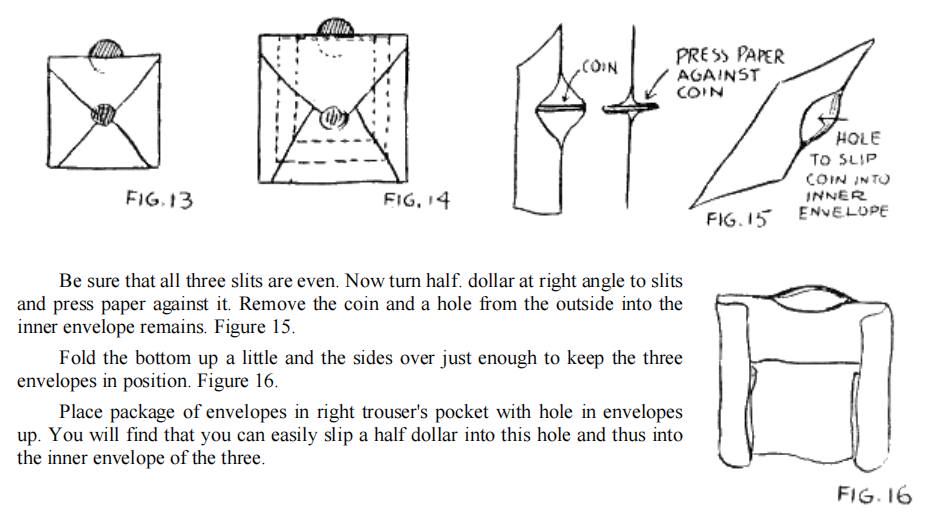
Be sure that all three slits are even. Now turn half. dollar at right angle to slits and press paper against it. Remove the coin and a hole from the outside into the inner envelope remains. Figure 15.
Fold the bottom up a little and the sides over just enough to keep the three envelopes in position. Figure 16.
Place package of envelopes in right trouser's pocket with hole in envelopes up. You will find that you can easily slip a half dollar into this hole and thus into the inner envelope of the three.
Take the other half sheet of paper and cut it into three squares as you did with the first. Make three envelopes. In the smallest one place the other half dollar. Seal envelope with sealing wax, enclose it in the next largest one. Then place these two in the largest one and seal it. Figure 17 shows how the three envelopes look when you have the whole package made.
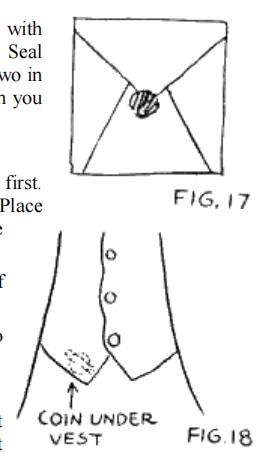
Crush this package into a ball.
Take another of the selected sheets and cut it in two as you did with the first. Take the half which matches the envelopes that you just screwed up into a ball. Place this on table with the ball just under it and concealed from audience. Place the other half sheet nearby.
If working with a suitcase, as is common with club work, just have ball of envelopes and paper in case.
Now take the third sheet of paper and cut it in half. Roll the two halves into a compact ball. Place it in right coat pocket.
Have a half dollar handy so that you can get at it easily for Finger Palming.
I suggest that you sew a half-inch piece of elastic under vest at lower right side. Insert half dollar in this, and when the time comes you can easily slip right fingers under edge of vest to Finger Palm it. Figure 18.
Or if you prefer, place the coin in a convenient pocket which you can reach easily when time comes to Finger Palm the coin in right hand.
Place stick of sealing wax in left coat pocket.
To Perform:
Have a spectator come up to help you. Ask him to be seated a moment and take charge of the stage while you go down into the audience and borrow a half dollar. Take coin from some gentleman in the audience, then return it and ask that he mark it so that he can easily identify it.
"Mark it well so that you can readily identify it in case you see it again -- or rather in case you do not see it again."
While he is marking it, get coin from under vest or from pocket and Finger Palm it. Have second, third, and fourth fingers curled around coin so that it cannot be seen by audience. You may grasp your coat lapel with right hand also to dispel any suspicion that you have something in right hand. Take marked coin between thumb and first two fingers of right hand, keeping back of hand uppermost.
Pretend to transfer coin to left hand, but as you toss coin, FRONT THUMB PALM the marked coin in right hand and let your own coin fall into left hand. Just before doing this bring the marked coin to Finger Tip Clip position so that movement will be easy. When you have disposed of your coin into left hand, let marked coin fall into regular Finger Palm position.
Go back to stage. Have assistant stand at your right as you face audience. Give him your coin from your left hand. The audience thinks, of course, that you have given him the borrowed marked coin. Tell assistant to close his hand over coin. Now you stand away from him for a moment, your left side toward audience.
"Now, Sir, if in three minute's time you were to open your hand and find the half dollar had vanished, you would be surprised, wouldn't you?"
Assistant says, "Yes," or laughs.
"And so should I."
As you talk to assistant, slip right hand into right trouser's pocket and let marked half dollar fall through the slit in the envelopes into the smallest one. When you do this, insert your first and second fingers into the slit to make it easy for coin to slide in. Close hole and roll envelopes into a ball. You will have no difficulty in doing this without being detected for audience is laughing at your last remark and there is a slight pause in your performing.
Remove hand from pocket.
THE IMPORTANT PART OF THE TRICK IS NOW DONE. The trick is really over before the audience thinks it has begun.
"Well, I am not going to do this trick that way. Money disappears easily enough without adding magical influence to it."
Go to table and pick up newspaper with ball of envelopes behind it. Hold it with right hand, thumb in front toward audience and rest of hand behind holding ball. Grasp other end of paper with left hand and fold it over in half. Open paper up, then close it again. Figure 19.

"I am going to ask you to place the half dollar on this piece of paper under my thumb."
Hold right hand toward assistant with paper folded over double and ball concealed under it. Have him place coin under your thumb. Figure 20.
Roll paper into a small ball with coin inside. Be careful to keep ball of envelopes concealed behind it. Hold the two balls together and hold them up as one for the audience to see.
"Strange thing about paper -- the smaller you roll it the smaller it becomes. Just take the half dollar wrapped up in the paper and hold it this way."
As you talk, turn the two balls of paper around so that ball of envelopes is on top. Press into left hand with cupped right hand. Figure 21.
Curl second, third, and fourth fingers of left hand around ball of paper underneath and palm it. Lift ball of envelopes away with right hand and hold up so that audience can see it.

Now turn to give this ball to assistant. Extend right hand to him and let left hand come up to grasp right sleeve at elbow. This is a natural movement and helps you to conceal palmed ball in left hand. Figure 22.
Hand ball to assistant.
"Hold it tight while I get some sealing wax."
Reach into left coat pocket with left hand and drop palmed ball therein as you bring out stick of sealing wax.
"Take the sealing wax and touch the back of your hand three times, then open your hand. What has happened? Nothing? Strange! Suppose you open the parcel and show it to the audience. After all, you know we must let them see part of the trick."
Take wax from assistant and replace in left coat pocket. Assistant unfolds paper and finds a large envelope instead of the half sheet of newspaper which he expects.
"The mystery deepens. What have we? An envelope, securely sealed with wax. I think the wax is still warm. Please open the envelope."
Assistant opens the envelope and takes out the second envelope.
"Another sealed envelope! Take it out. By the way, this is the very latest fashion in envelopes -- made of newspaper. Up en the second envelope."
Assistant opens it and takes out the third envelope.
"Well, a third one. Open it, please, and you will perhaps find the half dollar." Assistant opens third envelope and takes out half dollar.
"To show you that this is the same paper we started with, just examine the half dollar. You see it is the same."
Half dollar has marks on it and appears to be the same as the borrowed coin.
At this stage audience thinks the trick is done and will, no doubt, applaud you. Anyway, while assistant is identifying coin and audience is in that frame of mind, you can secretly prepare for the next stage of the trick.
Reach into right trouser's pocket and squeeze the envelopes into a ball. Remove the ball Finger Palmed in your right hand. Grasp your right coat lapel with right hand to conceal ball.
"Will you please take the coin down to the gentleman from whom we borrowed it? Or just a minute -- before you return the coin. Will you remember what I did so that you can do it when you get home? First I borrowed a half dollar, had it marked so that the owner would know it when he saw it again and then had it wrapped in a piece of newspaper."
Reach over with left hand and pick up newspaper. Turn your right side toward audience. Transfer paper to right hand so that it is held as in the beginning of the experiment with the ball behind it. Now turn to right so that your left side is a little toward audience.
IN PERFORMING THIS REPEATED VERSION QUICKEN YOUR MOVEMENTS. You are repeating and pretending to explain. As you know, it is not wise to repeat an experiment in Magic. In this case, however, it is all right for you leave the audience just as puzzled as they were after the first showing. Do it with plenty of snap nevertheless.
Request that assistant place coin on paper again.
"Place coin on paper again. That's it. Now you remember I rolled the paper into a ball and gave it to you."
Roll up paper into ball, exchange it for ball of envelopes in right hand, and give envelope ball to assistant. Palm other ball in left hand as illustrated in Figure 21.
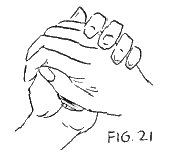
"And then I told you to touch it with a piece of sealing wax."
Reach into left coat pocket for wax and leave ball of paper there. Give wax to assistant.
"Touch it three times." Take back the wax.
"Now, all you have to do is to open the parcel and there are our envelopes. Open the first. Now the second. Now take the third one down to the owner of the coin and let him open the envelope and remove his half dollar."
Assistant takes envelope down to loaner of coin.
"Just as soon as the owner has removed his coin, will you please bring the envelope right back to me again?"
This prevents assistant from examining the coin too closely. While assistant is returning to stage, say to owner of coin,
"That is your coin, is it not? It is. Thank you."
YOU MUST IMPRESS ON YOUR AUDIENCE THE FACT THAT THE COIN IS THE ONE WHICH
YOU BORROWED, otherwise much of the effect is lost.
While all this is going on, it is easy for you to reach into your left coat pocket and Palm out the ball of paper from it. Grasp lapel of your coat again.
Now gather up envelopes from table and place ball of paper behind them. Say to assistant,
"Perhaps you would like to have all these envelopes as a souvenir of this little occasion. With the envelopes in your possession, you are sure to know how to do the experiment."
Take envelope from assistant and place with the rest. Show them freely, then roll them all up into a ball. Press Palmed ball against it and show both as one.
"Yours with pleasure."
Go through the routine as before, Palming ball of envelopes in left hand and handing ball of paper to assistant.
"And I suppose you want the magic sealing wax also."
Reach into pocket for sealing wax and leave ball of envelopes there.
"However, there is just a little warning I want to give you. Be careful when you are holding the envelopes in your hand not to touch your hand with the sealing wax." As you say this, touch his hand with the wax.
"Or you will find that the envelopes will turn right back to plain paper again. I believe, after all, that I had better keep the sealing wax. (Place it in pocket again.) Just open the paper now.
Assistant opens ball and finds the two half sheets of newspaper instead of the envelopes. Help him to spread them out.
"Well, anyway you know how it is done -- and perhaps some day you will be good enough to tell me so that I can do it myself."
NOTE: You should have no difficulty in getting coin into nest of envelopes in pocket. If you desire, however, you may make a little tube of cardboard or tin. This must be large enough to allow a half dollar to slide through easily and must have a big enough opening to find easily.
Have tube made 1-1/2 inches wide by 1-1/4 inches high by 1/4 inch deep. It is open, of course, at top and bottom. Have a piece at back by which to clip tube to envelopes. Figure 23.
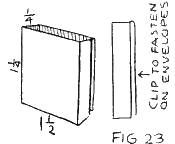
Figure 24 shows how tube fits into slits in the three envelopes. This allows an open passage for the coin into the smallest envelope. After coin has been dropped in, remove the tube and leave it in pocket.
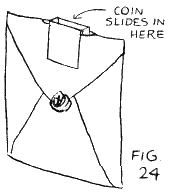
LESSON 23
A fascinating lesson with coins in which you learn to make the half dollars appear and disappear most mysteriously. You learn to pick them from here and there out of the air, from your elbow, from your knees, from a spectator's ear, from every imaginable place. And for presentation you learn these interesting effects:
1 -- The Miser's Dream. A quantity of coins are caught in rapid succession from the air with the empty hand, and are then tossed into a hat. More coins are then produced from your knees, from a lady's hair, etc.
2 -- A knot is tied in a borrowed handkerchief. A marked coin is then borrowed from a spectator and placed in an envelope. In a puzzling manner the coin travels from the envelope into the knot in the handkerchief.
3 -- Two clever methods for vanishing a coin which is wrapped in paper.
4 -- Two empty glass tumblers are shown. Into one are counted five half dollars. This is then held in left hand. Other glass is held in right hand some distance away. Upon command the coins pass one at a time from the left glass to the empty right one.
TARBELL SYSTEM, INCORPORATED, Chicago.
Bạn đang đọc truyện trên: truyentop.pro